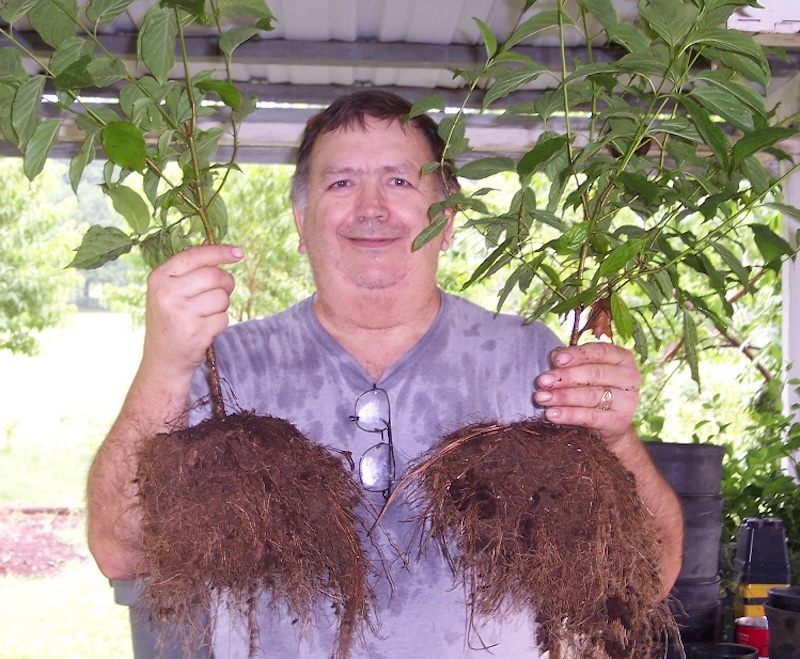Dogwoods are deciduous trees that make a big visual impact on a yard. Most varieties flower in spring and produce berries later in the growing season. These small trees put on a stunning foliage display during the fall, and some varieties even have colorful bark for a pop of color in a mostly bleak winter landscape. If their good looks weren’t enough, their laid-back care needs make them even more appealing. Dogwoods are easy to propagate, so you can create a stunning hedge or foundation planting or have plants to share with friends and family. Stem cuttings are the most effective method to propagate dogwood.

Photo by Albert McBee, cropped, Flickr, Copyright CC BY-SA 2.0 DEED
Methods To Propagate Dogwood
Dogwoods can be propagated from seed, but it is a long process. The seeds must experience a cold period to successfully germinate when the weather warms up. The resulting seedling will require several years of care before it is ready to be part of a landscape.
Stem cuttings often take about six weeks to root, making the entire process much quicker. Root stem cuttings in water or soil, although soil-propagated cuttings tend to be more durable. Some gardeners use rooting hormone for dogwood stem cuttings, but it isn’t necessary.
Many dogwoods spread by sucker growth to create a dense thicket. You can take advantage of this growth and divide a multi-stemmed shrub by cutting through the rootball between canes.You can also dig up suckers that pop up near the parent and transplant them to other parts of the garden or a container.
What You Need To Propagate Dogwood
You need a healthy dogwood tree, sharp pruning shears, and a container with drainage to propagate dogwood stem cuttings. Fill the pot with a rich, moist, well-drained potting mix. Cuttings can also be planted directly in the ground, but a pot makes it easier to control the environment. The cutting is more likely to succeed when placed in a humid environment, so many gardeners choose to tent the cutting with plastic to create a greenhouse effect.
Best Time To Propagate Dogwood
Dogwood stem cuttings need about six weeks to set roots and a couple more weeks to acclimate. Spring is the ideal time to start propagating dogwood cuttings. The cutting will have the entire growing season to root and settle in before cold weather arrives. Dogwood stem cuttings can be taken later in the growing season from mature wood, but the new plant may need to spend the winter indoors to prevent damage from frost.
Steps To Propagate Dogwood
Step 1 - Cut a stem section measuring at least 6 inches long below a node. Remove the lower leaves.
Step 2 - Prepare a container with moist, well-drained soil.
Step 3 - Dip the cut end in rooting hormone if using. Place the cut end in the prepared container so about 1 to 2 inches are submerged, including a couple nodes. The cutting can also be planted directly in the ground.
Step 4 - Water the new cutting so the potting mix is damp.
Step 5 - Place plastic over the cutting to create a damp environment.
Step 6 - Place the container in a spot that receives full sun.
Caring For Young Dogwood Stem Cuttings
A new dogwood stem cutting needs full sun and regular moisture. Keep the potting mix moist but not soggy. A naturally humid spot is a good choice, but you can increase the humidity by covering the pot with plastic. A plastic dome creates a mini greenhouse; the cutting will not need water as often if it is grown in high humidity. Always feel the potting mix before watering. The cutting should have roots in about six weeks.
Gently tug on the cutting; if you feel resistance, you know it has roots. Remove the plastic tent once the dogwood cutting has rooted. Keep the potting mix moist, as the new roots are sensitive to drying out. Upgrade to a larger container if you are rooting multiple cuttings in the same pot, or when the roots grow through the pot's drainage holes. Transplant the young dogwood outdoors when there is no chance of frost.
 |
Author Alison Cotsonas - Published 01-12-2024 |
